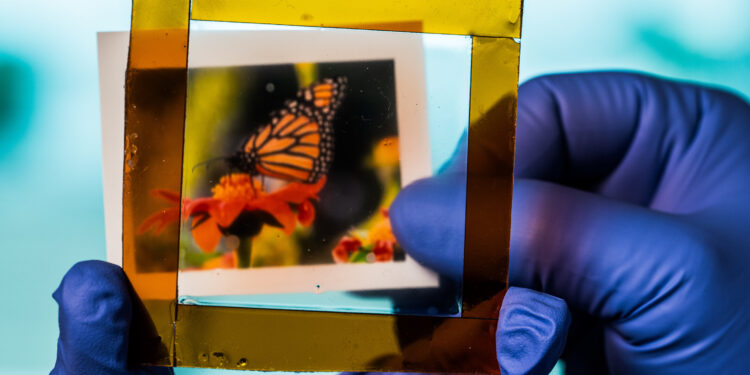Photograph seen through a piece of glass treated with a thermochromic mixture. Credit: Jeff Fitlow/Rice University.
Researchers at Rice University have developed a smart material that adjusts its transparency based on temperature changes, outperforming similar materials in terms of durability, transparency and responsiveness. The new polymer blend could significantly improve the energy efficiency of indoor space cooling, according to a new study published in Joule.
Cooling down can be a matter of life and death, but air conditioning, when available, already accounts for 7% of global energy consumption and 3% of carbon emissions. As temperatures soar and heatwaves become more frequent around the world, the need for more efficient ways to keep indoor temperatures under control has also become more urgent.
One way to address this problem is to coat windows with materials that keep heat out while still allowing light to pass through. Thermochromics are one such class of materials, but existing varieties are still too expensive and short-lived to be a viable choice for use in buildings, vehicles, and elsewhere.
The new salty polymer blending system developed by Rice engineers in the Nanomaterials Lab led by Pulickel Ajayan overcomes these challenges, potentially enabling the large-scale deployment of thermochromics as an energy-efficient indoor space cooling technology.
“Imagine a window that becomes less transparent as the temperature rises, keeping the interior cool without consuming energy,” says Sreehari Saju, a doctoral student in materials science and nanoengineering at Rice and co-senior author of the study. “Our formulation leverages both organic and inorganic components to overcome the limitations of existing thermochromic materials, such as their short lifespan and high cost.”
“In addition, the thermal response of this material is well suited to real-world environmental requirements. We believe that smart windows made from this material could significantly reduce the energy consumption of buildings, which would have a tangible impact on energy costs and carbon footprint.”
The researchers combined experimental methods with computer simulations to understand how the material would behave in different environmental and architectural settings. For example, they evaluated the material’s performance in specific urban areas around the world to get a sense of its potential impact when deployed at scale.
“Our approach was unique because it required a precise balance of materials and techniques that had not been explored before in this combination, offering a new avenue for the development of smart materials,” said Anand Puthirath, a research scientist in Ajayan’s research group and co-senior author of the study. “We conducted extensive experiments to characterize the material properties, as well as environmental stability and durability tests, showing that our blend can outperform existing thermochromics.”
The new thermochromic material developed in Pulickel Ajayan’s lab is applied to a glass plate. Credit: Jeff Fitlow/Rice University
The researchers synthesized the material by mixing two polymers with a type of salt and worked to optimize the composition to achieve smooth transitions between transparent and opaque states with temperature fluctuations. Their results show that the new thermochromic mixture is not only highly effective in regulating solar radiation, but also remarkably durable with an estimated lifespan of 60 years.
“These research results set new benchmarks for the durability and performance of thermochromics, particularly in a simple and practically viable system,” said Ajayan, corresponding author of the study and Rice’s Benjamin M. and Mary Greenwood Anderson Professor of Engineering and professor and chair of the Department of Materials Science and Nanoengineering.
“Our work addresses a crucial challenge in sustainable architecture, offering a practical and scalable solution to improve the energy efficiency of buildings.”
The thermochromic behavior of the material was studied in collaboration with Professor Yi Long and his doctoral student, Shancheng Wang, from the Department of Electronic Engineering at the Chinese University of Hong Kong, Sha Tin.
More information:
Sreehari K. Saju et al, Thermochromic Polymer Blends, Joule (2024). DOI: 10.1016/j.joule.2024.07.020
Joule
Provided by Rice University
Quote:Thermochromic material could make indoor temperature control more energy efficient (2024, August 28) retrieved August 28, 2024 from
This document is subject to copyright. Apart from any fair dealing for the purpose of private study or research, no part may be reproduced without written permission. The content is provided for informational purposes only.



